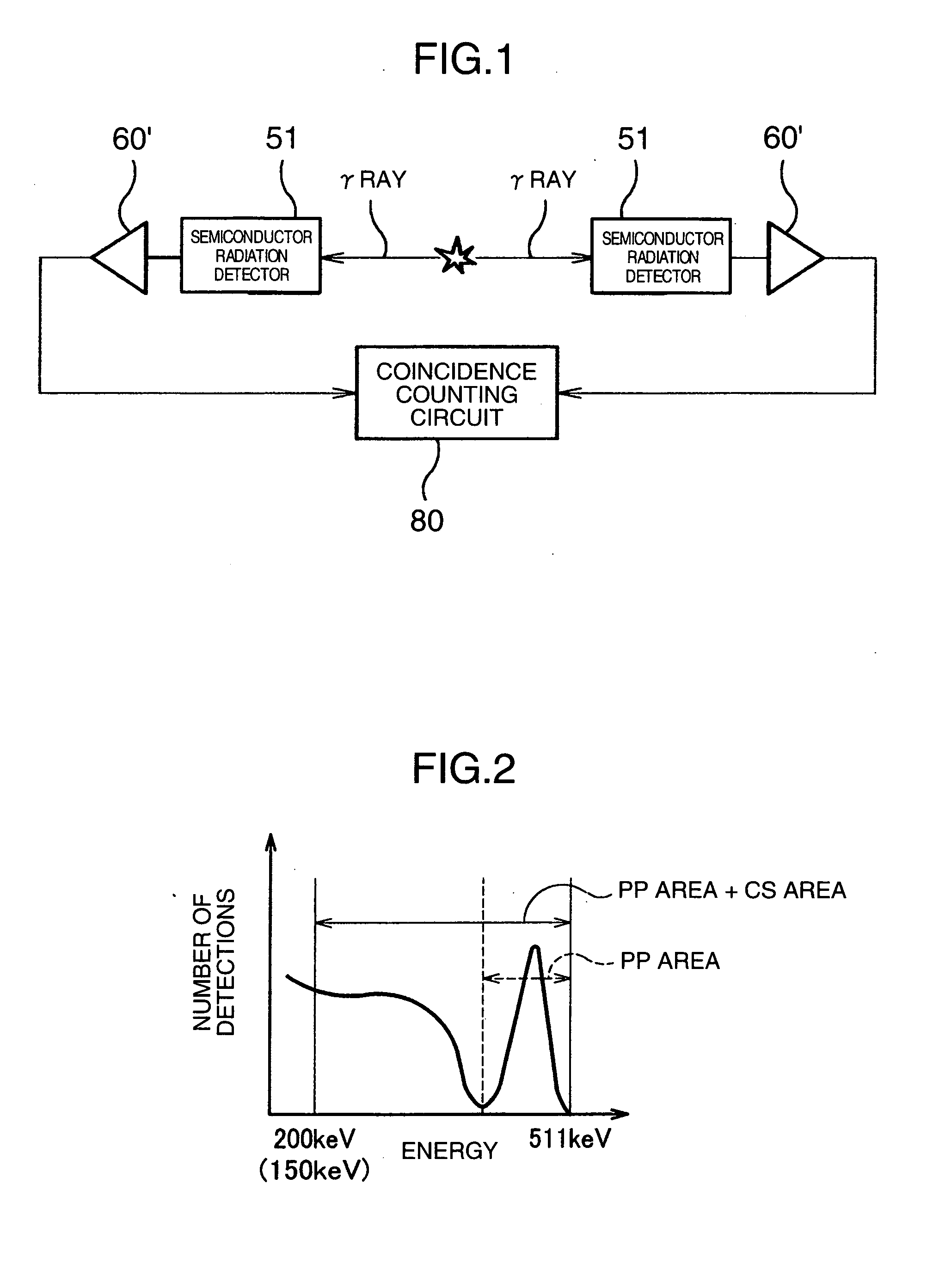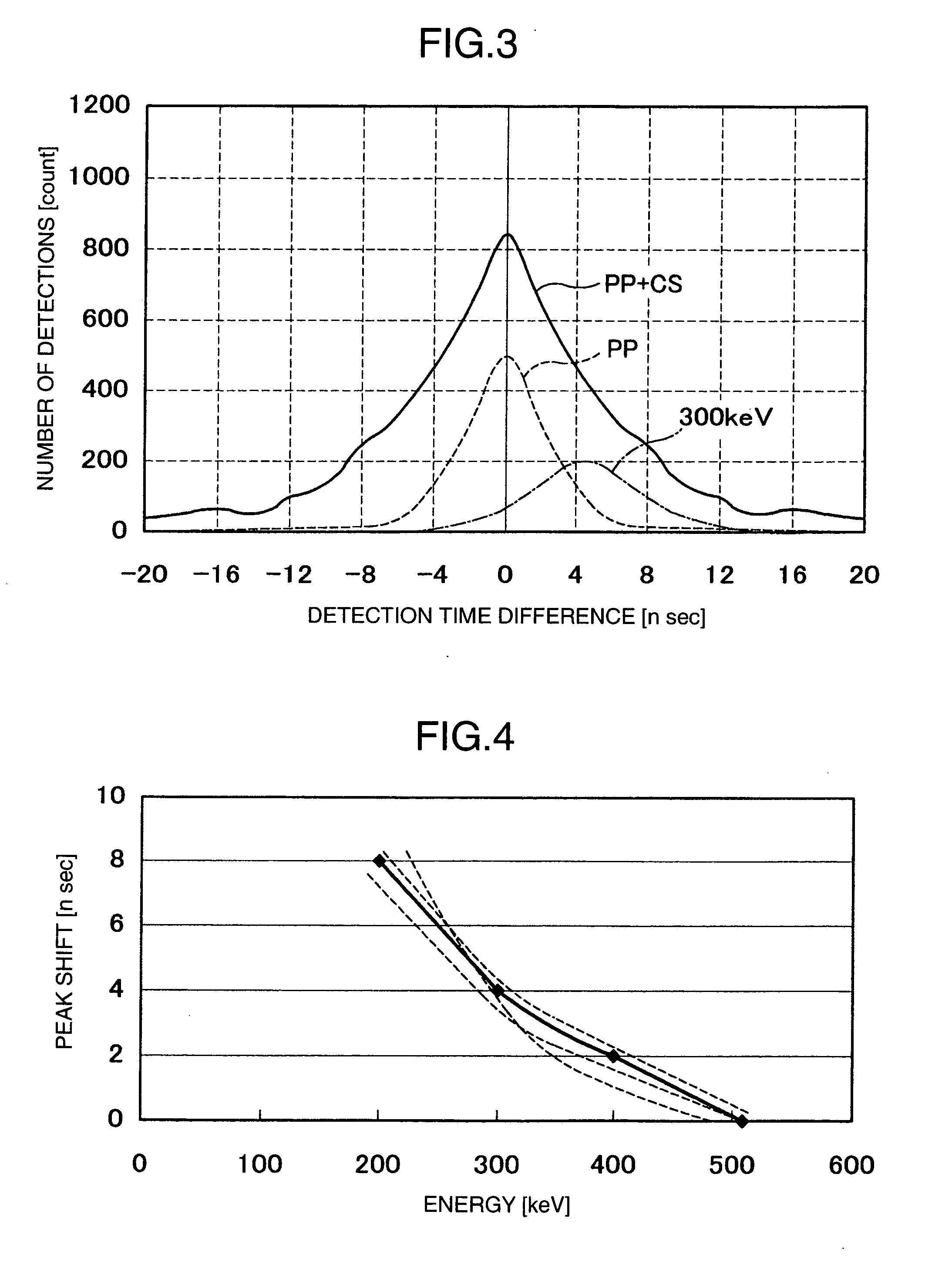Coincidence counting method of gamma ray and nuclear medicine diagnostic apparatus
a technology of coincidence counting and gamma rays, applied in the field of coincidence counting methods of rays, can solve the problems of inability to use low-energy rays and inability to extend the time window, so as to minimize the influence of other rays
- Summary
- Abstract
- Description
- Claims
- Application Information
AI Technical Summary
Benefits of technology
Problems solved by technology
Method used
Image
Examples
embodiment 1
[0029] First, regarding Embodiment 1 using scattered ray with a fixed time window, a principle, a concrete example, and the operations of the concrete example will be discussed in this order.
[Principle]
[0030] The principle of Embodiment 1 will be discussed below.
[0031] First, the present inventors clarified the relationship between energy (peak value) of a γ ray detected by a semiconductor radiation detector 51 and a difference in detection time (detection time difference) by using an experimental apparatus simplified in FIG. 1. The experimental apparatus of FIG. 1 comprises the semiconductor radiation detector 51 which acts as a detector for detecting γ rays and is made of cadmium telluride (CdTe), a circuit (γ-ray signal processing section 60′) which has the function of determining the energy of a detected γ ray and determining a detection time, and a coincidence counting circuit 80 which has the function of measuring a detection time difference relative to energy based on the ...
embodiment 2
[0065] Regarding Embodiment 2 using scattered ray with a variable time window, the following will discuss a principle, a concrete example, and the operations of the concrete example in this order. An explanation about the same parts as Embodiment 1 is omitted.
[Principle]
[0066] The principle of Embodiment 2 will be discussed below.
[0067] According to the experiments using the experimental apparatus (FIG. 1) described in Embodiment 1, the present inventors found that a difference in detection time (detection time difference) occurs according to the energy of a γ ray (FIG. 3). Based on this knowledge, a detection time is corrected in Embodiment 1 (FIGS. 4 and 5). In Embodiment 2, a time window is corrected instead of a detection time.
[0068] In FIG. 10 showing an example of a time window correction table, a horizontal axis represents a difference in energy between successively detected 7 rays (keV) and a vertical axis represents a correction value (nsec) of the time window. As is un...
concrete example
[0070] Referring to FIG. 11 and others, a concrete example of Embodiment 2 will be discussed below.
[0071] A PET apparatus 1′ of Embodiment 2 is similar in appearance to that of Embodiment 1 (FIG. 7). As shown in FIG. 11, a γ-ray detection signal detected by a semiconductor radiation detector 51 is processed in a γ-ray detection signal processing section 60′. Unlike the γ-ray detection signal processing section 60 of Embodiment 1, the γ-ray detection signal processing section 60′ has a typical configuration not having a time correction circuit 70 (or a time correction table). This is because Embodiment 2 makes a time window variable instead of correcting the detection time of a γ ray.
[0072] As shown in FIG. 11, a coincidence counting circuit 80′ of Embodiment 2 comprises a time window correction table 81. The coincidence counting circuit 80′ has the function of making the time window variable and performing coincidence counting using the first inputted signal (signals (N, τ, E) fro...
PUM
 Login to View More
Login to View More Abstract
Description
Claims
Application Information
 Login to View More
Login to View More - R&D
- Intellectual Property
- Life Sciences
- Materials
- Tech Scout
- Unparalleled Data Quality
- Higher Quality Content
- 60% Fewer Hallucinations
Browse by: Latest US Patents, China's latest patents, Technical Efficacy Thesaurus, Application Domain, Technology Topic, Popular Technical Reports.
© 2025 PatSnap. All rights reserved.Legal|Privacy policy|Modern Slavery Act Transparency Statement|Sitemap|About US| Contact US: help@patsnap.com



